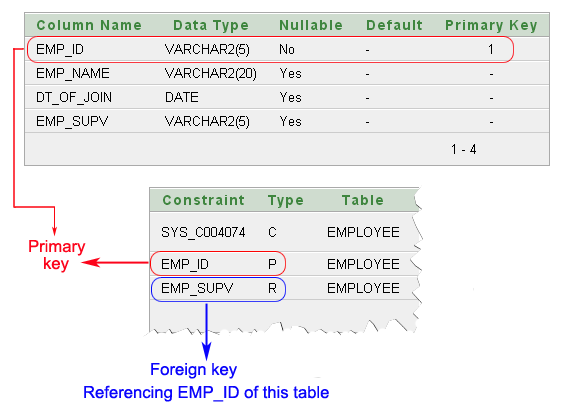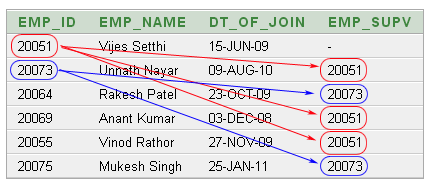SQL Self Join
What is Self Join in SQL?
A self join is a join in which a table is joined with itself (which is also called Unary relationships), especially when the table has a FOREIGN KEY which references its own PRIMARY KEY. To join a table itself means that each row of the table is combined with itself and with every other row of the table.
The self join can be viewed as a join of two copies of the same table. The table is not actually copied, but SQL performs the command as though it were.
The syntax of the command for joining a table to itself is almost same as that for joining two different tables. To distinguish the column names from one another, aliases for the actual the table name are used, since both the tables have the same name. Table name aliases are defined in the FROM clause of the SELECT statement. See the syntax :
SELECT a.column_name, b.column_name... FROM table1 a, table1 b WHERE a.common_filed = b.common_field;
For this tutorial we have used a table EMPLOYEE, that has one-to-many relationship.
Code to create the table EMPLOYEE
SQL Code:
CREATE TABLE employee(emp_id varchar(5) NOT NULL,
emp_name varchar(20) NULL,
dt_of_join date NULL,
emp_supv varchar(5) NULL,
CONSTRAINT emp_id PRIMARY KEY(emp_id) ,
CONSTRAINT emp_supv FOREIGN KEY(emp_supv)
REFERENCESemployee(emp_id));The structure of the table

In the EMPLOYEE table displayed above, emp_id is the primary key. emp_supv is the foreign key (this is the supervisor’s employee id).
If we want a list of employees and the names of their supervisors, we’ll have to JOIN the EMPLOYEE table to itself to get this list.
Unary relationship to employee
How the employees are related to themselves:
- An employee may report to another employee (supervisor).
- An employee may supervise himself (i.e. zero) to many employees (subordinates).
We have the following data into the table EMPLOYEE.

The above data shows:
- Unnath Nayar's supervisor is Vijes Setthi
- Anant Kumar and Vinod Rathor can also report to Vijes Setthi.
- Rakesh Patel and Mukesh Singh are under supervison of Unnith Nayar.
Example of SQL SELF JOIN
In the following example, we will use the table EMPLOYEE twice and in order to do this we will use the alias of the table.
To get the list of employees and their supervisor the following SQL statement has used:
SQL Code:
SELECT a.emp_id AS "Emp_ID",a.emp_name AS "Employee Name",
b.emp_id AS "Supervisor ID",b.emp_name AS "Supervisor Name"
FROM employee a, employee b
WHERE a.emp_supv = b.emp_id;Output:

Outputs of the said SQL statement shown here is taken by using Oracle Database 10g Express Edition.
See also:
Practice SQL Exercises
- SQL Exercises, Practice, Solution
- SQL Retrieve data from tables [33 Exercises]
- SQL Boolean and Relational operators [12 Exercises]
- SQL Wildcard and Special operators [22 Exercises]
- SQL Aggregate Functions [25 Exercises]
- SQL Formatting query output [10 Exercises]
- SQL Quering on Multiple Tables [8 Exercises]
- FILTERING and SORTING on HR Database [38 Exercises]
- SQL JOINS
- SQL SUBQUERIES
- SQL Union[9 Exercises]
- SQL View[16 Exercises]
- SQL User Account Management [16 Exercise]
- Movie Database
- BASIC queries on movie Database [10 Exercises]
- SUBQUERIES on movie Database [16 Exercises]
- JOINS on movie Database [24 Exercises]
- Soccer Database
- Introduction
- BASIC queries on soccer Database [29 Exercises]
- SUBQUERIES on soccer Database [33 Exercises]
- Hospital Database
- Employee Database
- More to come!
Want to improve the above article? Contribute your Notes/Comments/Examples through Disqus.
Previous: Join a table to itself
Next: Joining tables through referential integrity
SQL: Tips of the Day
SQL Server SELECT into existing table.
INSERT INTO dbo.TABLETWO SELECT col1, col2 FROM dbo.TABLEONE WHERE col3 LIKE @search_key
This assumes there's only two columns in dbo.TABLETWO - you need to specify the columns otherwise:
INSERT INTO dbo.TABLETWO (col1, col2) SELECT col1, col2 FROM dbo.TABLEONE WHERE col3 LIKE @search_key
Database: SQL Server
Ref: https://bit.ly/3y6tpA3
- New Content published on w3resource:
- HTML-CSS Practical: Exercises, Practice, Solution
- Java Regular Expression: Exercises, Practice, Solution
- Scala Programming Exercises, Practice, Solution
- Python Itertools exercises
- Python Numpy exercises
- Python GeoPy Package exercises
- Python Pandas exercises
- Python nltk exercises
- Python BeautifulSoup exercises
- Form Template
- Composer - PHP Package Manager
- PHPUnit - PHP Testing
- Laravel - PHP Framework
- Angular - JavaScript Framework
- Vue - JavaScript Framework
- Jest - JavaScript Testing Framework
